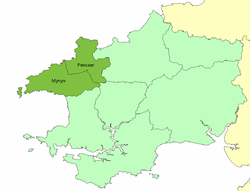- Dewisland (hundred)
-
Coordinates: 51°56′53″N 5°08′28″W / 51.948°N 5.141°W
The Hundred of Dewisland (often written "Dewsland") was a hundred in the north west of Pembrokeshire, Wales. It was formed by the Act of Union of 1536 and was essentially identical to the pre-Norman cantref of Pebidiog[1]: one of the seven cantrefs of Dyfed.
Named after Dewi Sant, the Welsh name for Saint David,[2] Dewisland is in north-western Pembrokeshire, including the city of St David's and the peninsula on which it stands.[3] Almost all of the hundred was within the Marcher Lordship of the Bishop of St David's, and St David's was its civil and ecclesiastical headquarters. It was said to be divided into two commotes: Mynyw (Latin: Menevia) and Pencaer.[4]
Dewisland boasts of being the only part of Wales never conquered by a foreign invader. The English before the Conquest did not get so far, and the Normans respected Dewisland as a possession of the Church, so that it was spared the fierce fighting which took place everywhere else when they conquered Wales.[5] Nevertheless, it was occupied by the Normans in the 12th century, and made part of the March, but remained exclusively Welsh-speaking, except for small English plantations in the City of St David's and at Abercastle and Letterston. These were extinct by the time of George Owen, who described the hundred as wholly Welsh-speaking.[6]
The Petty Sessions for the hundred were held at Solfach.[7]
Notes
- ^ Charles, B. G., The Placenames of Pembrokeshire, National Library of Wales, Aberystwyth, 1992, ISBN 0-907158-58-7, p 197
- ^ William Owen Pughe, Cambrian register vol. 2 (1799), p. 79: "...it took the name ot Dewisland among the Englishmen, for that it was given to the bishop's see of St. Davids."
- ^ Reports of the Commissioners of Inquiry into the State of Education in Wales (1848), p. 39: "(Dewisland hundred): — This district embraces the north-west quarter of Pembrokeshire."
- ^ W. Rees, An Historical Atlas of Wales, Faber & Faber, 1959, plate 28
- ^ Raphael Samuel, Alison Light, Theatres of Memory: Island stories : unravelling Britain (1997), p. 51
- ^ Owen, George, The Description of Pembrokeshire, Dillwyn Miles (Ed), Gomer Press, Llandysul, 1994, ISBN 185902-120-4
- ^ Nicholas Carlisle, A topographical dictionary of ... Wales, a continuation of the topography of the United Kingdom of Great Britain and Ireland (1811), Solfach
Ancient hundreds of Pembrokeshire Categories:- History of Pembrokeshire
- Hundreds of Wales
Wikimedia Foundation. 2010.

